
The Westaby manure application
operation in Iowa has grown along with the hog industry in the state,
using application equipment from the main-line manufacturers and doing
some innovating of its own with custom-designed injectors.
The Westaby manure application operation in Iowa has grown along with the hog industry in the state, using application equipment from the main-line manufacturers and doing some innovating of its own with custom-designed injectors.
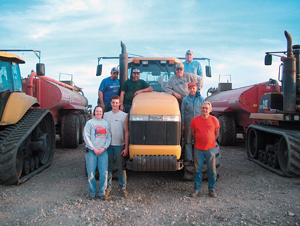 The Westaby manure application crew with a Cat Challenger tractor. At the front left are Sarah and Jesse Westaby; at the top left is Gary McVicker, with Kevin Westaby beside him; on the right side of the Cat from front to back are John Tessman, Marlo Westaby, Leon Fahrmann, and Vern Gordon. The Westaby manure application crew with a Cat Challenger tractor. At the front left are Sarah and Jesse Westaby; at the top left is Gary McVicker, with Kevin Westaby beside him; on the right side of the Cat from front to back are John Tessman, Marlo Westaby, Leon Fahrmann, and Vern Gordon. |
Kevin Westaby has been handling hogs—and hog manure—since he was a teenager. So it’s really not surprising that he’s now running a business helping Iowa hog farm operators deal with their manure.
The manure volumes now, of course, are one heck of a lot greater than his high school days, when he was active in the Future Farmers of America, and owned only a few hogs. Case in point: last year, Westaby, along with partners Leon Fahrmann and Jesse Westaby, and employees hauled some 45 million gallons of manure.
When he started the commercial application business in 1991, there were many customers in the 50,000 to 70,000 gallon range. A farm with 100,000 gallons was considered to be a big customer. Fast forward to 2005, and the average size of a customer haul is a stunning 750,000 gallons. “We still have good customers that we haul 100,000 gallons for, but I can probably count them on one hand,” says Westaby.
Westaby comes to the business naturally, with a farm and agricultural feed background. And running his own manure hauling and application business suits him.
Westaby’s entrepreneurial nature certainly came in handy right through the 1990s, as Iowa experienced a virtual explosion in large-scale hog farms, accompanied by a huge need to handle all the resulting hog manure. Westaby has ridden that expansion wave, and along the way worked hard to provide customers with top-notch service. When they hit the 15 million gallon mark, he got some help and was joined in the business by Gene Lackore, who became a partner.
“When we first started out, custom application was kind of a new business,” he notes. But it has been a business that has grown in leaps and bounds. “Our customer base was almost expanding faster than we could service it.”
And although there has been substantial growth, the business still has a strong and loyal long-term core customer base. “With a lot of our customers, we are the only ones who have ever pumped manure out of their farms.” That brings some definite benefits in being familiar with the individual farm operations, with their land and how best the manure can be applied to that land. “I think they know that we do a good job and they rely on us.”
The Westaby hauling/application operation has become an integral part of the extended operations systems for many of these farms. “Often the first time we’ll hear from customers will be a phone call letting us know they are ready to go, and they know we will take care of them.” They have about 60 customers that they do regular work for.
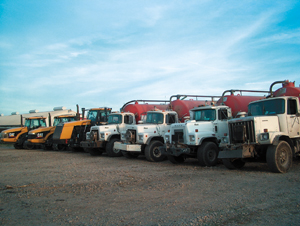 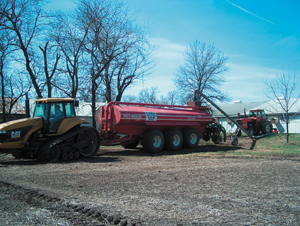 The equipment line-up at the Westaby operation includes Cat Challenger tractors, triple-axle Mack trucks with floatation tires, a GMC triple-axle truck with flotation tires, J-Star tanks and custom built vacuum tanks. The equipment uses custom-designed injector toolbars designed by Jesse Westaby. |
On the equipment side, Westaby’s first unit was a homemade 3,000-gallon tank truck. But it wasn’t too long before he took on other equipment. These days the equipment line-up includes: a Cat 45 Challenger tractor with a J-Star 7,200-gallon tank with a custom designed seven-shank telescoping injector; three triple-axle Mack trucks with floatation tires, 5,000-gallon, custom built vacuum tanks and specially developed four-shank
injectors; a Cat 65 tractor with J-Star 7,200-gallon tank with the custom designed seven-shank telescoping injector toolbar, owned by Vern Gordon; and a GMC triple-axle truck with flotation tires, 5,000-gallon, custom-built vacuum tank and the custom-designed, four-shank injector, owned by Gary McVicker.
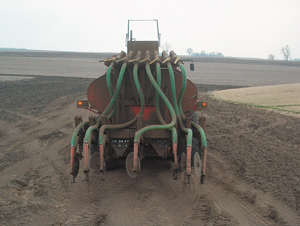 Everything is measured in feet, and operators know how far they have to travel to achieve a certain application rate. All the rigs are equipped with Calc-An-Acre measuring systems, to determine application rates. Everything is measured in feet, and operators know how far they have to travel to achieve a certain application rate. All the rigs are equipped with Calc-An-Acre measuring systems, to determine application rates. |
Their most recent purchase came last year, when they added a Cat 55 Challenger with a J-Star 7,200-gallon tank with the custom-designed toolbar. Handling the wheel on that unit is Jesse Westaby’s wife, Sarah.
Kevin’s son, Jesse, was involved in the business for a number of years on a part-time basis, and became a partner in 2002. Jesse, who trained as a tool and die maker and mechanic, seems to have found a solid niche with the company. Two years ago, he redesigned the injection equipment they were working with, making it more efficient and easier to handle. The end result was the specially designed, seven-shank telescoping injection toolbar, mentioned with the equipment above.
The seven-shank toolbar uses three different sized square tubes and two 36-inch hydraulic cylinders to slide the tubes in and out. It essentially works like an oversized radio antenna. Fully extended, it spreads a 17.5-foot swath, then pulls in to 9.5 feet to allow for easy passing on the road. The biggest benefit to the seven-shank injection system is the reduction in application time in the field. It reduces their unloading time by about one third over a standard four- or five-shank system.
“As the seven-shank toolbar shows, Jesse is not afraid to experiment with equipment, to see if it will work better,” notes Kevin.
They are pretty much a family operation, Kevin explains, with the people they have operating manure application equipment—such as driver John Tessman—considered part of a tight extended family.
Kevin’s father, Marlo, runs the pumps for them at the hog sites. Kevin’s wife, Colette, works in the business, too, taking care of pumps and parts to keep their equipment up and running.
“We’re a pretty close-knit bunch,” he says. Former partner Gene Lackore, who Westaby bought out in an amicable business deal two years ago, still keeps his hand in the business, by helping out two to three days a week during the application season.
Just as he keeps the employee base tight for the company, Westaby also tries to keep their operating area close, as well. “We try to operate within a fairly tight circle of about 30 miles or so.” Although, he adds, they continue to service some longer-term customers outside that radius. They also handle the manure from their own 1,000-hog farm, a contract custom feeding operation.
When operations are going full tilt, Westaby says it is a logistical challenge to keep things as efficient as possible. They work days, but only days, he notes, consciously opting not to go 24 hours a day. “We’ll leave in the dark in the morning, and come home in the dark at night, but its only days.” That said, though, when they come home at night, sometimes there’s a few more hours spent doing monkey-wrenching on their equipment. “There’s always stuff that needs to be fixed,” he notes. They also work a six-day week, always taking Sunday off.
The management challenge is most acute during busy times. “The spring and fall bring long hours, and it’s a stretch to keep on top, but we do it.
“It’s the moving time between sites that gets expensive,” he adds. “As long as the tanks are hauling and they have something in them, they are generating revenue. Moving time costs money, so we have developed operations to the point where we are pretty efficient when we do move.”
Westaby says they have been fortunate in that they face fairly short hauls to apply the manure—the longest might be four miles. But if regulations governing phosphorous levels are brought in over the next few years, that may dictate application over a broader area, he notes. “In the future, we may have hauls of five to 10 miles and at that point we are going to have to address how best to do that.”
They also try to stay flexible, though. There are more wean-to-finish sites in Iowa now, and if Westaby has enough lead-time, they will make the effort to pump a site when it is empty, before the piglets are brought in. And weather, of course, is a huge factor in when and where they can apply manure.
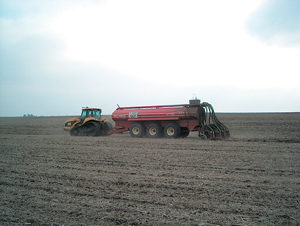 The average size of a customer haul for Westaby is now 750,000 gallons. Kevin Westaby points out, however, that they still have good customers for whom they haul 100,000 gallons. The average size of a customer haul for Westaby is now 750,000 gallons. Kevin Westaby points out, however, that they still have good customers for whom they haul 100,000 gallons. |
On the equipment side, both Kevin and Jesse are constantly looking at how things could be made more efficient. They often make alterations to the pumps—J-Star and Houle—that they use. “About 95 percent of the manure we haul comes out of concrete pitted buildings, eight feet deep,” explains Westaby. “With the pumps, the elbow for the loading pipe comes off the pump three feet in the air, which means we have to lift the hose up to hook it up on the pump. But we’ll modify the pump so the elbow comes out flat on the ground, which means we can connect the hose up and keep if flat on the ground.” It may not represent a major change to the pumps, he says, but it sure makes things simpler in setting up equipment.
The pumps they work with are six inchers. Westaby says they tried using an eight-inch, load-out pump a few years back, but it seemed to be more trouble than it was worth in terms of the pump being awkward to move. “We decided to stay with the six-inch pumps—we give up a bit of extra loading capacity, but we have better connection/moving times with the six-inch pumps. Sometimes bigger is not necessarily better.”
On the pump side, they work with a 40-foot J-Star lagoon pump, three J-Star chopper pumps and one Houle chopper pump. Four AC tractors are used on the pumps. They have two 30-foot Gooseneck hydraulic beaver tail trailers that are used to haul the pumps and pump tractors from site to site.
An innovation that has made life easier on the J-Star tanks is steerable axles. Not that this was a great problem before, but it has now eliminated 95 percent of their wheel bearing problems. It also reduces tire sidewall problems, because the tires are not twisting as much with the steerable axles.
In general terms, they look for hydraulics, rather than mechanical, on any of their equipment. “Any time we can get away from anything mechanical, we like it,” says Westaby. “We’ve had good luck with the hydraulic-driven pumps on the J-Star tanks and eliminating the PTO shaft.”
|
Manure applicators’ associations exchanging information
Kevin Westaby was among a group of about 10 commercial manure
applicators in Iowa who three years ago started up a state association—the Iowa Commercial Nutrient Applicators Association—to unite commercial and confinement site manure applicators.
Westaby notes that many issues concerning the livestock sector of
the Ag industry have been passed into law over the past several years without input from this sector. The association’s intent is to address the issues impacting applicators in a united way. The association has a quarterly newsletter, and regular meetings are held to discuss the issues that affect Iowa applicators. It currently has about 45 members.
For further information about the Iowa Commercial Nutrient
Applicators Association, contact Kevin Westaby at kwestaby@frontiernet.net or Joan O’Brien of the Agribusiness Association of Iowa at (800) 383-1682 or by e-mail at joano@agribiz.org.
And the Iowa association is looking to get even more united on a
broader front. They have been working with groups in Wisconsin, Minnesota, Illinois, Ohio and Pennsylvania to set up a regional applicators’ association. “It’s good to get together and exchange information among the different operators and the different states,” says Westaby.
These state groups are also behind the Manure Expo show, a regional
show all about manure, which is held every two years. Please see page 26 for a preview story on Manure Expo. |
While the operation has looked at GPS equipment, they have not adopted it yet. There are no flow meters on the tanks; everything is measured in feet, and operators know how far they have to travel to achieve a certain application rate. All the rigs are equipped with Calc-An-Acre measuring devices, to determine their application rates.
“If we had a big turnover in employees, we would probably take a closer look at doing flow meters,” says Westaby. “But everybody running the tanks and trucks knows the equipment, and is very experienced. They know we are applying for fertilizer value, and that we need to do a good job.
“With the help that I have now, I’m very comfortable in not having to spend the money to put flow meters on the tanks.” Although, he adds, they might be forced at some point to put on flow meters and GPS technology due to changes in environmental regulations.
Besides, Westaby points out, manure is not a consistent product. Extremely detailed measurement tools are more useful when spreading material such as commercial fertilizer, which is the same consistency from the top of the barrel to the bottom. “But we don’t have a consistent load from the first load out of the manure pit to the last load out of the pit. It varies.”
In the future, he sees them moving away from the truck-mounted tanks, and moving more towards pull tanks. The pull tanks give him more flexibility with some of the local farmers he employs on a part-time basis; they feel more comfortable operating a Challenger and pulling a tank than driving a truck-mounted tank.
In spite of the 18-hour days and six-days-a-week operation, Westaby is glad that he made the move to setting up his own application business almost 15 years ago. Like other custom applicators, he has those not-so-good times when the day is full of one challenge after another. “But overall, I like being in business for myself.”
On top of that, the manure application business provides a livelihood for other members of his family, and he works with people he trusts implicitly.
A sidenote is that in his years in the business, Westaby has seen it become more professional, both on the farm end and the hauling end, and it continues to evolve and improve. “Manure used to be treated as waste, to be hauled out to the field to get rid of it. Now, it’s being used as a nutrient and valuable fertilizer. There are some big benefits in that.”
Is more growth in store for the Westaby operation? “That’s a good question,” he says, with a laugh. “We haven’t fully discussed that at this point.” But there are about a dozen new large-scale hog operations going up around nearby Alexander, Iowa. Those hog sites represent many millions more gallons of manure that need to be hauled and applied.
“We’re comfortable where we’re at, but then I have a hard time telling people ‘no’ when there is an opportunity.”